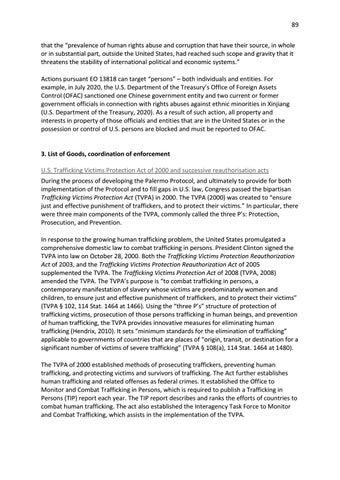89 that the “prevalence of human rights abuse and corruption that have their source, in whole or in substantial part, outside the United States, had reached such scope and gravity that it threatens the stability of international political and economic systems.” Actions pursuant EO 13818 can target “persons” – both individuals and entities. For example, in July 2020, the U.S. Department of the Treasury’s Office of Foreign Assets Control (OFAC) sanctioned one Chinese government entity and two current or former government officials in connection with rights abuses against ethnic minorities in Xinjiang (U.S. Department of the Treasury, 2020). As a result of such action, all property and interests in property of those officials and entities that are in the United States or in the possession or control of U.S. persons are blocked and must be reported to OFAC.
3. List of Goods, coordination of enforcement U.S. Trafficking Victims Protection Act of 2000 and successive reauthorisation acts During the process of developing the Palermo Protocol, and ultimately to provide for both implementation of the Protocol and to fill gaps in U.S. law, Congress passed the bipartisan Trafficking Victims Protection Act (TVPA) in 2000. The TVPA (2000) was created to “ensure just and effective punishment of traffickers, and to protect their victims.” In particular, there were three main components of the TVPA, commonly called the three P’s: Protection, Prosecution, and Prevention. In response to the growing human trafficking problem, the United States promulgated a comprehensive domestic law to combat trafficking in persons. President Clinton signed the TVPA into law on October 28, 2000. Both the Trafficking Victims Protection Reauthorization Act of 2003, and the Trafficking Victims Protection Reauthorization Act of 2005 supplemented the TVPA. The Trafficking Victims Protection Act of 2008 (TVPA, 2008) amended the TVPA. The TVPA’s purpose is “to combat trafficking in persons, a contemporary manifestation of slavery whose victims are predominately women and children, to ensure just and effective punishment of traffickers, and to protect their victims” (TVPA § 102, 114 Stat. 1464 at 1466). Using the “three P’s” structure of protection of trafficking victims, prosecution of those persons trafficking in human beings, and prevention of human trafficking, the TVPA provides innovative measures for eliminating human trafficking (Hendrix, 2010). It sets “minimum standards for the elimination of trafficking” applicable to governments of countries that are places of “origin, transit, or destination for a significant number of victims of severe trafficking” (TVPA § 108(a), 114 Stat. 1464 at 1480). The TVPA of 2000 established methods of prosecuting traffickers, preventing human trafficking, and protecting victims and survivors of trafficking. The Act further establishes human trafficking and related offenses as federal crimes. It established the Office to Monitor and Combat Trafficking in Persons, which is required to publish a Trafficking in Persons (TIP) report each year. The TIP report describes and ranks the efforts of countries to combat human trafficking. The act also established the Interagency Task Force to Monitor and Combat Trafficking, which assists in the implementation of the TVPA.













